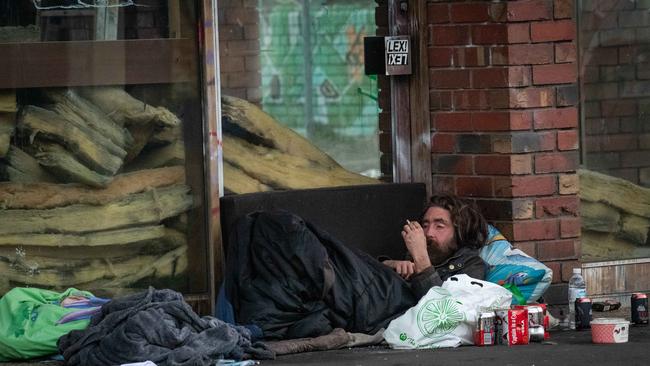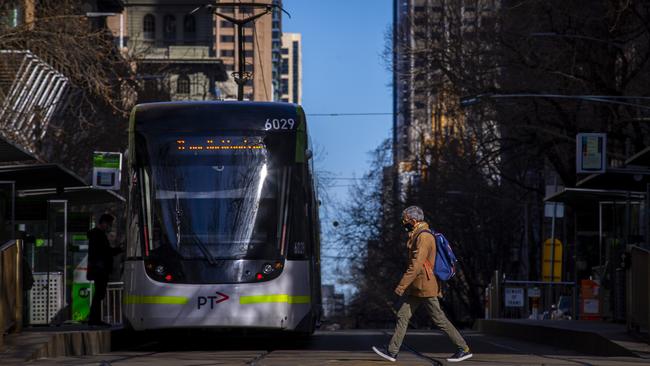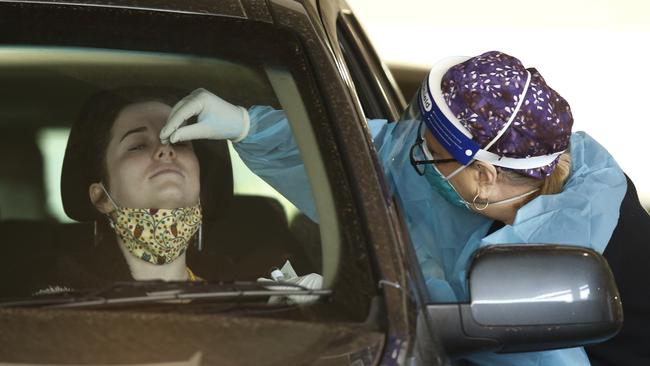Victorians are staring into an economic abyss
Manageable suppression is Daniel Andrews’s plan of attack, and it will be reflected in Sunday’s announcement.

In many instances, the loudest critics have had the least skin in the game, encouraging a form of back door civil disobedience that is doing nothing to take the national economy forward.
Never mind the doctors, we know best.
Using epidemiological evidence is often considered an optional extra when running thin arguments built on ideology rather than good policy. Why Victoria should look to Sweden. Why Daniel Andrews should (mindlessly and unthinkingly) rush to fully reopen the economy. Why a dodgy drug should be handed out even though the health experts aren’t convinced.
While we are it, off with those damned masks!
But as the Victorian Premier made clear on Friday, with the support of his Chief Health Officer, the state isn’t ready to lift its foot entirely off the COVID-19 brake. No need to send more venom their way, their view is backed by the numbers.
Professor Brett Sutton said: “This is the stubborn tail of the epidemic curve.”
As Andrews explained about the need to hold the line on lifting restrictions: “This is not a choice, this is not something we are choosing to do.”
Well of course there are choices, but what he is saying is now is not the time to fully open up the Victorian economy because the consequences would be foolishly catastrophic.
Commonsense, and basic statistics, say he is right. Open up too fast, and hard-fought gains would be lost in weeks. Even if Sunday’s road map to recovery provides limited relaxation of these awful curbs on our freedom. No one likes the loss of freedom.
The expert advice, with high double-digit new cases each day and higher, is that fully opening up the economy needs to occur progressively and only after the cases have been driven way down, possible even into single digits.
This is not about elimination but manageable suppression. This is transparently Andrews’s plan of attack, and it will be reflected in Sunday’s announcement.

None of the above is to excuse the Victorian government for its calamitous handling of hotel quarantine, poor contact tracing, mediocre messaging or misplaced arrogance. But it is to urge people to use their common sense, particularly those looking from afar at a vast community that is deep in a form of mourning.
For many months I have been telling people who are up to hearing it that Victoria is entering a colossal economic downturn that will cause intergenerational pain.
The damage has already been done. There will be many people sleeping on the streets. Many forced to flee interstate. There will be holes in the roads, and the Victorian schools and hospitals will suffer greatly. Barring another gold rush or imminent vaccine, it cannot be anything else.
Melbourne’s CBD is entombed in a viral cemetery. It may not fully recover, certainly in the manner to which we knew in February.
While Sydney understandably built itself around its harbour, Melbourne exists around its city centre, populated as it is by international students, the universities, retail and the big end of town. It will be well into 2021 before we know the extent of the challenges facing the state.
But it is clear the Morrison government has been spooked by the data trickling through to Treasury. The Weekend Australian has been told the recession facing Victoria is deeper than anything anyone was expecting. Equally, though, the picture around the country is also bleak, although probably not in the abyss territory.
Until the pandemic, Melbourne was on track to become Australia’s most populous city some time this decade. That seems highly unlikely to happen before 2030 or beyond. While the state has been held up by population growth for many years, you can almost feel the young and the middle-aged lining up at the Queensland border.
Treasurer Josh Frydenberg has had a tough week, confirming the first recession for decades. It is understandable he is applying pressure on Andrews to provide a road map out of the pandemic. He is right to do so.
But Frydenberg also knows that he needs a low COVID-19 Victoria to ensure that the national economy recovers.
“There is a road out, there is hope and the national economy is really operating at two speeds right now,” he told Melbourne’s 3AW this week.

“There is Victoria, and then there is the rest. And outside of Victoria, the jobs have started to come back. Of the 1.3 million people who lost their job or saw their hours reduced to zero since the start of the crisis, more than half, around 700,000, are now back at work,” he said.
“Obviously, the situation in Victoria is a lot more challenging, so we will look forward to seeing a fair dinkum road map out of this crisis from Daniel Andrews when he reveals it this Sunday.”
The continuing fracturing of the national cabinet is not at all surprising, with Canberra increasingly keen to control the economic narrative. The national economy has been hammered because of the coronavirus, particularly by Victoria, and the Prime Minister will remain intent on protecting his position.
Scott Morrison governs with a slender majority, while Andrews has a commanding rule over the parliament, with the Coalition holding just 27 of 88 seats.
While a recession-led wipe-out of Victorian Labor is quite possible, it’s pretty easy to see that the Coalition has a long way to go to hold office in its own right.
A driving force of the federal concerns is whether or not Andrews and his Treasurer, Tim Pallas, are up to the challenge of truly engaging or understanding industry and business.
Both men are being savaged behind the scenes by the private sector for having too few connections with — and too little interest in — the largest employment group in Australia.
Andrews’s language can be weak. He clearly places more emphasis on unions and community groups, which he sees as his path to remaining in power.
Even though he boasts of his own family’s links to small business and agriculture.
“It is my background that I look to,’’ he said on Friday.
Andrews will only come under more pressure from now on, given the horrific looming toll on businesses. It’s hard to overstate the extent to which the private sector has been routed by the virus and the shutdowns, particularly after the avoidable second wave.
Victorian CFMEU leader John Setka is urging Andrews to reopen the entire building industry, declaring 300,000 construction workers need to go back to work.
“We implemented extreme safety measures well beyond those we were required to do in the early stages of the pandemic to ensure the protection of all construction workers,” he wrote to the Premier.
“These procedures meant we were better placed than any other industry to continue working and we must be allowed to do just that — not only to protect the livelihoods of the 300,000-plus Victorian construction workers but to lead the recovery of the Victorian economy.”
It is a terrible thing to see the scores of cranes in Melbourne’s CBD so idle. Anyone who thinks the effects of the coronavirus will suddenly disappear by the end of next year is deluded. Or that a short-term approach to reopening Victoria will change much at all.
This is a long-term challenge that requires the nation to look over the horizon and not be panicked into calamitous short-term decision making.




For the best part of six months, it has seemed that Melburnians have been locked up and shouted at in equal measure. The collective Victorian morale has been battered by a lot of venomous scapegoating as millions stare into an economic abyss.